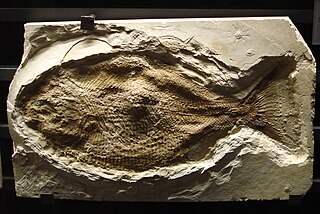
Pholidophorus is an extinct genus of stem-teleost fish. Numerous species were assigned to this genus in the past, but only the type species Pholidophorus latiusculus, from the Late Triassic of Europe, is considered to be a valid member of the genus today.

Pachycormus is an extinct genus of pachycormiform ray-finned fish known from the Early Jurassic of Europe. The type species P. macropterus was first named as a species of Elops by Henri Marie Ducrotay de Blainville in 1818, it was placed into the newly named genus Pachycormus by Louis Agassiz in 1833. Fossils have been found in marine deposits from France, Germany and England. Pachycormus has recently been considered monotypic, only containing P.macropterus, with other species considered junior synonyms of the former, though this has subsequently been questioned. Pachycormus has generally been considered basal among Pachycormiformes, with a recent phylogeny finding it to be the second most basal pachycormiform after Euthynotus. It grew up to 1 m (3.5 ft) in length. The teeth are short and designed for grasping. Its ecology has been interpreted as that of a generalist predator. Stomach contents indicate that its diet included cephalopods, and small fish, including juvenile Pachycormus. One particular specimen shows that it died because of swallowing an ammonite too large for its size, and the ammonite itself was only shortly digested just before the fish's death.
Neopholidophoropsis is an extinct genus of stem-teleost ray-finned fish that lived in what is now Germany during the Aptian stage of the Early Cretaceous epoch. It contains one species, Neopholidophoropsis serrata.

Saurostomus is an extinct genus of prehistoric bony fish that lived during the early Toarcian stage of the Early Jurassic epoch.

Euthynotus is an extinct genus of prehistoric bony fish that lived during the early Toarcian stage of the Early Jurassic epoch. It is generally considered the basalmost pachycormiform.
Songanella is an extinct genus of prehistoric bony fish that lived during the early Tithonian stage of the Late Jurassic epoch.

Leptolepides is an extinct genus of prehistoric ray-finned fish that lived during the early Tithonian stage of the Late Jurassic epoch.

Eichstaettia is an extinct genus of prehistoric bony fish that lived during the early Toarcian stage of the Early Jurassic epoch.
Liodesmus is an extinct genus of prehistoric bony fish that lived during the early Toarcian stage of the Early Jurassic epoch.
Protoclupea is an extinct genus of ray-finned fish that lived from the Oxfordian to the early Tithonian stage of the Late Jurassic epoch. It contains one species, Protoclupea chilensis, fossils of which have been found in the Domeyko Range of Antofagasta Region, northern Chile. The genus has been placed in the family Varasichthyidae together with the genera Bobbichthys, Domeykos, Luisichthys and Varasichthys.
Eugnathides is an extinct genus of prehistoric bony fish that lived from the Oxfordian to the early Tithonian stage of the Late Jurassic epoch. Eugnathides may have been similar to Sphaerodontes.

Luisichthys is an extinct genus of ray-finned fish that lived in what is now Cuba from the Oxfordian to the early Tithonian stage of the Late Jurassic epoch. It contains one species, Luisichthys vinalesensis.

Heterostrophus is an extinct genus of ray-finned fish belonging to the family Dapediidae. It lived from the Callovian stage of the Middle Jurassic epoch to the early Tithonian stage of the Late Jurassic epoch.

Eurycormus is an extinct genus of prehistoric bony fish that lived from the Callovian stage of the Middle Jurassic epoch to the early Tithonian stage of the Late Jurassic epoch.
Proleptolepis is an extinct genus of ray-finned fish belonging to the family Leptolepidae.

Saurorhynchus is an extinct genus of carnivorous bony fish that lived during the Early and Middle Jurassic epochs. Fossils have been found in Europe and North America (Canada). It is commonly found in pelagic and lagoonal deposits, but mostly marine. Largest specimens can grow up to 1.9 metres (6.2 ft).
Pholidophoristion is an extinct genus of stem-teleost ray-finned fish that lived in what is now Europe from the Late Jurassic to the Early Cretaceous.
Plesiococcolepis is an extinct genus of prehistoric ray-finned fish. It belongs to the family Coccolepididae and is known from the Early Jurassic of Lingling-Hengyang, Hunan, China.

Peipiaosteus is an extinct genus of prehistoric chondrostean ray-finned fish. Its fossils are found in the Early Cretaceous Jiufotang Formation, Pani Lake, Liaoning Province, China.

Morrolepis is an extinct genus of prehistoric coccolepidid "palaeoniscoid" ray-finned fish that lived during the Late Jurassic and earliest Cretaceous epochs in Europe, Asia and North America.


















